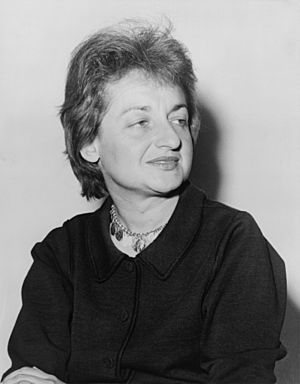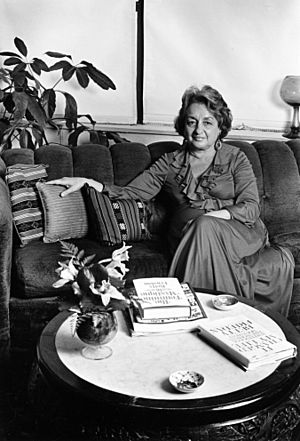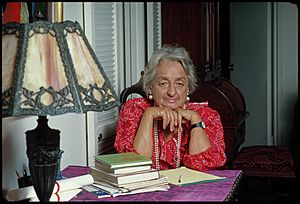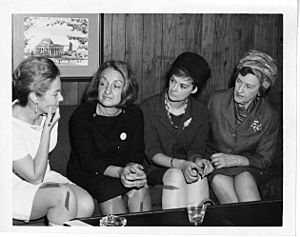Betty Friedan facts for kids
Quick facts for kids
Betty Friedan
|
|
|---|---|

Friedan in 1960
|
|
| Born |
Bettye Naomi Goldstein
February 4, 1921 Peoria, Illinois, U.S.
|
| Died | February 4, 2006 (aged 85) Washington, D.C., U.S.
|
| Education | |
| Occupation |
|
|
Notable work
|
The Feminine Mystique (1963) |
| Spouse(s) |
Carl Friedan
(m. 1947–1969) |
| Children | 3, including Daniel Friedan |
| Scientific career | |
| Influences | Simone de Beauvoir |
Betty Friedan (born February 4, 1921 – died February 4, 2006) was an American writer and activist. She was a very important leader in the women's movement in the United States. Her book, The Feminine Mystique, published in 1963, is often seen as the starting point for the "second wave" of feminism in America during the 20th century.
In 1966, Friedan helped create the National Organization for Women (NOW). She was also elected its first president. NOW's goal was to help women become full and equal partners with men in American society.
In 1970, after her time as NOW's president, Friedan organized the nationwide Women's Strike for Equality. This happened on August 26, which was the 50th anniversary of women getting the right to vote in the U.S. The strike was very successful and helped the feminist movement grow. A march led by Friedan in New York City had over 50,000 people!
In 1971, Friedan joined other important feminists to start the National Women's Political Caucus. This group aimed to get more women involved in politics. Friedan also strongly supported the Equal Rights Amendment (ERA). This proposed amendment to the U.S. Constitution would make sure everyone has equal rights, no matter their gender.
Betty Friedan was seen as an important writer and thinker in the United States. She stayed active in politics and advocacy until the late 1990s. She wrote six books in total.
Contents
Early Life
Betty Friedan was born Bettye Naomi Goldstein on February 4, 1921, in Peoria, Illinois. Her parents were Harry and Miriam Goldstein. Her father owned a jewelry store. Her mother started writing for a newspaper when her father became ill. Miriam's new work outside the home seemed to make her much happier.
As a young girl, Friedan was involved in Jewish groups and also groups that discussed social fairness. She felt that her strong feelings against unfairness came from seeing how people were treated unfairly because they were Jewish.
She went to Peoria High School. She joined the school newspaper. When her idea for a column was not accepted, she and six friends started their own magazine called Tide. It focused on home life instead of school life.
Friedan went to Smith College, a women's college, in 1938. She earned a scholarship for her excellent grades in her first year. She became interested in poetry and had many poems published on campus. In 1941, she became the editor-in-chief of the college newspaper, SCAN. Under her leadership, the newspaper became more focused on political topics. She graduated with top honors in 1942, majoring in psychology.
In 1943, she spent a year at the University of California, Berkeley. She studied psychology further with a special scholarship. She became more involved in political activities. In her own writings, she said that her boyfriend at the time convinced her not to continue her studies and give up her academic career.
Writing Career
Before The Feminine Mystique
After leaving college, Betty became a journalist. She wrote for publications that supported workers' rights and social change. From 1943 to 1946, she wrote for Federated Press. From 1946 to 1952, she worked for the UE News, a newspaper for electrical workers.
Friedan was let go from UE News in 1952 because she was pregnant with her second child. After that, she became a freelance writer. She wrote for different magazines, including Cosmopolitan.
The Feminine Mystique
For her 15-year college reunion in 1957, Friedan surveyed her classmates. She asked them about their education, their experiences after college, and how happy they were with their lives. She started writing articles about what she called "the problem that has no name." Many housewives wrote back, feeling relieved that they were not alone in feeling this way.
Friedan then decided to turn this topic into a book, The Feminine Mystique. It was published in 1963. The book described the lives of women in modern societies, especially the role of a full-time homemaker. Friedan felt this role could be very limiting.
In her book, Friedan wrote about a suburban housewife who felt sad and trapped. This woman had left college at 19 to get married and raise children. Friedan shared her own fear of being alone. She also wrote that she had never seen a positive example of a woman who worked outside the home and also had a family. She shared many stories of housewives who felt similarly stuck.
Friedan argued that women are just as capable as men for any type of work or career. She challenged the ideas from media, teachers, and psychologists that said otherwise. Her book was important because it questioned the unfair treatment of women in American society. It also differed from earlier arguments for women's rights.
Earlier feminists often believed women had a special nature. They thought that women getting the right to vote or an education would make them better wives and mothers. Friedan, however, based women's rights on "the basic human need to grow." She believed everyone has a need to become all they can be.
The limits placed on women in the 1950s, and the feeling of being trapped, resonated with many American women. They soon began meeting in groups to talk about their experiences. They also started working to change unfair laws and social ideas that limited women.
The book became a huge bestseller. Many historians believe it was the main reason for the "second wave" of the women's movement in the United States. It greatly influenced events in the country and around the world.
Other Works
Friedan published six books. Some of her other books include The Second Stage, It Changed My Life: Writings on the Women's Movement, and The Fountain of Age. Her autobiography, Life so Far, was published in 2000.
She also wrote for many magazines and newspapers, such as McCall's, The New York Times Magazine, and Ladies' Home Journal.
Activism in the Women's Movement
National Organization for Women
In 1966, Friedan helped create the National Organization for Women (NOW). She became its first president. Some of NOW's founders, including Friedan, were inspired because the Equal Employment Opportunity Commission (EEOC) was not enforcing a law that banned sex discrimination. They gathered in Friedan's hotel room and decided to form a new group. Friedan even scribbled the acronym "NOW" on a paper napkin.
Under Friedan's leadership, NOW strongly pushed for women and men to be equal under the law. NOW worked to make sure that laws like the Civil Rights Act of 1964 and the Equal Pay Act of 1963 were followed. These laws were important early wins for the movement. NOW also made the EEOC take claims of sex discrimination seriously.
They successfully pushed for a rule in 1967 that gave women the same affirmative action opportunities as Black Americans. They also pushed for a 1968 EEOC decision that made it illegal to have separate "help wanted" ads for men and women. NOW also supported the Equal Rights Amendment (ERA) and pushed for national daycare centers.
NOW also helped women get equal access to public places. For example, the Oak Room at the Plaza Hotel in New York used to have lunches only for men. In 1969, Friedan and other NOW members protested, and the rule was changed.
Friedan stepped down as president in 1969. In 1973, she founded the First Women's Bank and Trust Company.
Women's Strike for Equality
In 1970, NOW, with Friedan leading, played a key role in stopping President Richard M. Nixon's choice for the Supreme Court, G. Harrold Carswell. He had opposed the 1964 Civil Rights Act, which gave women equality in the workplace.
On August 26, 1970, which was the 50th anniversary of the Women's Suffrage Amendment, Friedan organized the national Women's Strike for Equality. She led a march of about 20,000 women in New York City. The main goals of the march were to promote equal opportunities for women in jobs and education. Protesters also demanded the creation of child-care centers.
Politics
In 1971, Friedan, along with many other women's movement leaders, including Gloria Steinem, founded the National Women's Political Caucus. This group aimed to increase women's participation in politics.
In 1972, Friedan tried to become a delegate for the Democratic National Convention to support Congresswoman Shirley Chisholm. Friedan played a very important role at the convention and spoke to the attendees.
Movement Image and Unity
Betty Friedan was one of the most important feminists of the 20th century. She believed the feminist movement should focus on economic issues. These included equal pay and opportunities in jobs and business. She also pushed for child care and other ways for both women and men to balance family and work.
Influence
Friedan is often given credit for starting the modern feminist movement. Her book, The Feminine Mystique, is considered one of the most important books in American feminism. Her work as an activist and her book have greatly influenced writers, teachers, journalists, activists, and everyday women involved in the feminist movement.
Allan Wolf, in The Mystique of Betty Friedan, wrote that she "helped to change not only the thinking but the lives of many American women." While there have been some discussions about her work, there is no doubt that her efforts for women's equality were sincere and dedicated.
Historians like Daniel Horowitz have explored Friedan's involvement with the women's movement even before she wrote The Feminine Mystique. This shows that her feminist ideas started earlier than many people thought, even in the 1940s.
Friedan was also featured in the 2013 documentary Makers: Women Who Make America, which was about the women's movement. In 2014, a biography of Friedan was added to the American National Biography Online.
Personal Life
Betty married Carl Friedan, a theater producer, in 1947. She continued to work after marriage. The couple divorced in May 1969. Carl passed away in December 2005.
Carl and Betty Friedan had three children: Daniel, Emily, and Jonathan. Betty was raised in a Jewish family, but she was an agnostic, meaning she was unsure about the existence of God. In 1973, Friedan was one of the people who signed the Humanist Manifesto II, a statement of humanist beliefs.
Death
Betty Friedan passed away from heart failure at her home in Washington, D.C., on February 4, 2006. It was her 85th birthday.
Lessons We Can Learn from Betty Friedan
Betty Friedan's life and work offer many valuable lessons that are still important for us today, no matter our age or gender.
- Speak Up for Fairness and What You Believe In
If you see something that isn't fair, or if you feel that something could be better, it's important to speak up. Betty Friedan noticed that many women were quietly unhappy, and she decided to write a whole book about it. She didn't just keep her observations to herself; she shared them with the world, which led to big changes.
- Dream Big and Pursue Your Full Potential
Betty Friedan encouraged everyone, especially women, to think beyond what society expected of them and to pursue their own dreams and talents. She believed that everyone has unique abilities and should have the chance to develop them, whether that's through education, a career, or any other passion.
- The Importance of Equal Opportunities for Everyone
A core idea from Betty Friedan's work is that all people, regardless of their gender, should have the same chances and opportunities in life. This means equal access to education, jobs, leadership roles, and the freedom to make their own choices about their lives.
- Working Together Can Create Big Changes
Betty Friedan didn't just write a book; she helped start an organization (NOW) to bring people together to work for change. She understood that while one person can start an idea, many people working together can make that idea a reality.
- Question Old Ideas and Stereotypes
Betty Friedan challenged the traditional ideas about what women "should" do. She showed that sometimes, what people have always believed isn't necessarily the best or only way. It's good to think critically and ask "why?" or "what if?"
Awards and Honors
- Honorary doctorate from Smith College (1975)
- Humanist of the Year from the American Humanist Association (1975)
- Mort Weisinger Award from the American Society of Journalists and Authors (1979)
- Honorary doctorate from the State University at Stony Brook (1985)
- Eleanor Roosevelt Leadership Award (1989)
- Honorary doctorate from Bradley University (1991)
- Inducted into the National Women's Hall of Fame (1993)
- Honorary doctorate from Columbia University (1994)
- Listed as one of "The 75 Most Important Women of the Past 75 Years" by Glamour magazine (2014)
In Media
Betty Friedan was played by actress Tracey Ullman in the 2020 TV series Mrs. America.
She was also shown in an episode of the HBO Max series "Julia." In the scene, Friedan talks with Julia Child and suggests that Child's cooking show might not be helpful for women.
Books
- The Feminine Mystique (1963)
- It Changed My Life: Writings on the Women's Movement (1976)
- The Second Stage (1981)
- The Fountain of Age (1993)
- Beyond Gender (1997)
- Life So Far (2000)
See also
 In Spanish: Betty Friedan para niños
In Spanish: Betty Friedan para niños




